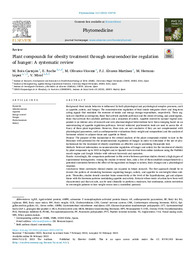Título :
Plant compounds for obesity treatment through neuroendocrine regulation of hunger: A systematic review |
Autor :
Herranz López, María Dolores
Boix Castejón, Marina 
Roche, E.
Olivares Vicente, Mariló
Álvarez-Martínez, Francisco Javier 
Micol, Vicente  |
Editor :
Elsevier |
Departamento:
Departamentos de la UMH::Bioquímica y Biología Molecular |
Fecha de publicación:
2023-05 |
URI :
https://hdl.handle.net/11000/34907 |
Resumen :
Background
Food intake behavior is influenced by both physiological and psychological complex processes, such as appetite, satiety, and hunger. The neuroendocrine regulation of food intake integrates short- and long-term acting signals that modulate the moment of intake and energy storage/expenditure, respectively. These signals are classified as orexigenic, those that activate anabolic pathways and the desire of eating, and anorexigenic, those that activate the catabolic pathways and a sensation of satiety. Appetite control by natural vegetal compounds is an intense area of research and new pharmacological interventions have been emerging based on an understanding of appetite regulation pathways. Several validated psychometric tools are used to assess the efficacy of these plant ingredients. However, these data are not conclusive if they are not complemented with physiological parameters, such as anthropometric evaluations (body weight and composition) and the analysis of hormones related to adipose tissue and appetite in blood.
Purpose
The purpose of this manuscript is the critical analysis of the plant compounds studied to date in the literature with potential for the neuroendocrine regulation of hunger in order to determine if the use of phytochemicals for the treatment of obesity constitutes an effective and/or promising therapeutic tool.
Methods
Relevant information on neuroendocrine regulation of hunger and satiety for the treatment of obesity by plant compounds up to 2022 in English and/or Spanish were derived from online databases using the PubMed search engine and Google Scholar with relevant keywords and operators.
Results
Accordingly, the comparison performed in this review between previous studies showed a high degree of experimental heterogeneity. Among the studies reviewed here, only a few of them establish comprehensively a potential correlation between the effect of the ingredient on hunger or satiety, body changes and a physiological response.
Conclusions
More systematic clinical studies are required in future research. The first approach should be to decode the pattern of circulating hormones regulating hunger, satiety, and appetite in overweight/obese subjects. Thereafter, studies should correlate brain connectivity at the level of the hypothalamus, gut and adipose tissue with the hormone patterns modulating appetite and satiety. Extracts whose mode of action have been well characterized and that are safe, can be used clinically to perform a moderate, but continuous, caloric restriction in overweight patients to lose weight excess into a controlled protocol.
|
Palabras clave/Materias:
Adipohormones
Appetite
Energy control
Hunger
Phytochemicals
Satiety |
Área de conocimiento :
CDU: Ciencias puras y naturales: Biología |
Tipo de documento :
info:eu-repo/semantics/article |
Derechos de acceso:
info:eu-repo/semantics/openAccess
Attribution-NonCommercial-NoDerivatives 4.0 Internacional |
DOI :
https://doi.org/10.1016/j.phymed.2023.154735 |
Publicado en:
Phytomedicine
Volume 113, May 2023, 154735 |
Aparece en las colecciones:
Artículos - Bioquímica y Biología Molecular
|
 La licencia se describe como: Atribución-NonComercial-NoDerivada 4.0 Internacional.
La licencia se describe como: Atribución-NonComercial-NoDerivada 4.0 Internacional.
.png)
